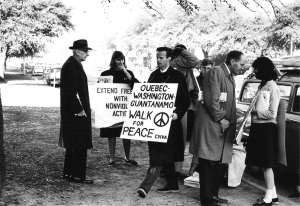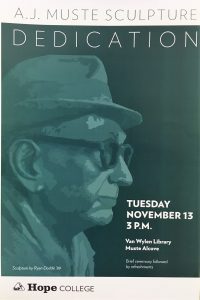Professor of English Kathleen Verduin shares her insights on a Hope icon, prior to the dedication of Muste’s sculpture on November 13 at 3pm at Van Wylen Library.
Tell me you’ve heard of him: Abraham Johannes Muste (1885-1967), labor leader, world-renowned pacifist, and probably Hope’s most famous alumnus.
 Born in the Netherlands, Muste immigrated to Grand Rapids with his family in 1891. He graduated from Hope College in 1905: valedictorian, captain of the basketball team, president of his fraternity (the Fraters, of course), and already an acclaimed orator. He studied at New Brunswick Seminary and was ordained as a pastor in the Reformed Church in America in 1909. From there, he served the Fort Washington Collegiate Church in New York City, but found himself increasing uncomfortable with the doctrines of Calvinism, and moved on to a Congregational Church near Boston.
Born in the Netherlands, Muste immigrated to Grand Rapids with his family in 1891. He graduated from Hope College in 1905: valedictorian, captain of the basketball team, president of his fraternity (the Fraters, of course), and already an acclaimed orator. He studied at New Brunswick Seminary and was ordained as a pastor in the Reformed Church in America in 1909. From there, he served the Fort Washington Collegiate Church in New York City, but found himself increasing uncomfortable with the doctrines of Calvinism, and moved on to a Congregational Church near Boston.
The year 1917, when the United States declared war on Germany, was a dramatic watershed for the young man: despite social pressures around him, he adopted a position of radical pacifism.
Muste had already joined over sixty fellow pacifists to found the American wing of the international Fellowship of Reconciliation. Next, abandoning his pulpit, he turned toward labor organization as a theater where his commitment to issues of peace and justice could find expression.
In 1921, he became educational director of the Brookwood Labor College in New York and laid foundations for the Conference for Progressive Labor Action. Frustrated with the church, he was drawn for a time to Communism, even visiting the noted Marxist Leon Trotsky in 1936. “What could one say to the unemployed and the unorganized who were betrayed and shot down when they protested”? he asked himself. “What did one point out to them? Well, not the Church … you saw that it was the radicals, the Left-wingers, the people who had adopted some form of Marxian philosophy, who were doing something about the situation.”
And yet A. J. didn’t have it in him to stay away from Christianity for very long. That same year he wandered into the Church of St. Sulpice in Paris and experienced a reconversion: “Without the slightest premonition of what was going to happen, I was saying to myself: ‘This is where you belong.’” On his return to the United States, Muste headed the Presbyterian Labor Temple in New York and then became Executive Secretary of the Fellowship of Reconciliation.
In 1949 a very young Martin Luther King, Jr., then at student at Crozer Seminary, heard Muste lecture on non-violent resistance. It may even be fair to say that King would not have achieved his ambitions had he not had Muste as an example.
In his years of “retirement,” Muste was more vigorous than ever, participating in a string of activities: the anti-nuclear walk to Mead Airforce Base, where the seventy-five-year old climbed over the fence into the grounds; the San Francisco to Moscow Walk for Peace, the Quebec-Guantanamo Peace Walk, the Nashville-Washington Walk, and the Sahara Project to oppose nuclear testing in Africa.
In 1966, in the heat of the Vietnam War, he led a group to Saigon, where he was immediately deported, but shortly thereafter flew to Hanoi to meet Ho Chi Minh. Less than a month later Muste died of an aneurysm. The great American linguist, philosopher, and social critic Noam Chomsky called Muste “one of the most significant twentieth-century figures, an unsung hero.”
During the summer of 2017, I had the great privilege of accompanying David Schock on a series of cross-country trips to interview and record the memories of people who knew A. J. or had written about him. It was an unforgettable experience, and the footage is priceless. We heard the stories—often expressed in tears—of working with Muste, observing his deft administration, and wondering at his dedication. What is the cost of a life like Muste’s, a life that so realizes the imitatio Christi?
Surely Muste paid a price: his family’s finances were chronically precarious, he was often away from home, and he endured the suspicion of many with whom he had grown up. One person we interviewed estimated that Muste had probably owned no more than four suits in his entire life, and his shoes often revealed patches in the soles.
Yet Muste was a happy man. I love this story from his co-worker Barbara Deming, who was with him when he was arrested in Vietnam: “None of us had any idea how rough they might be,” she recalled, “and A. J. looked so very frail.” She went on: “I looked across the room at A. J. to see how he was doing. He looked back with a sparkling smile and, with that sudden light in his eyes which so many of his friends will remember, he said, ‘It’s a good life!’”
Though Muste wasn’t an English major, he was a lover of poetry, so it seems fitting to end with some of the lines that most inspired him. These words, from Stephen Spender’s “The Truly Great,” were read at his memorial service: “I think continually of those who were truly great. / Who, from the womb, remembered the soul’s history / Through corridors of life, where the hours are suns, / Endless and singing.”
Visit Digital Holland for a timeline of Muste’s life, and be sure to check out Hope’s A. J. Muste Web page.

